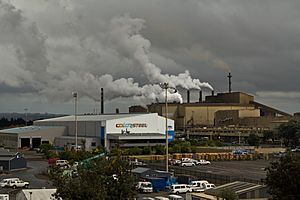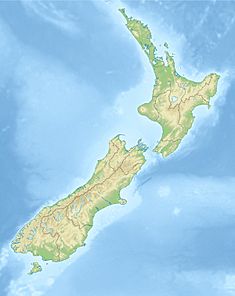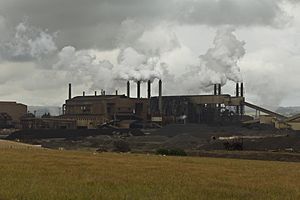New Zealand Steel facts for kids

Glenbrook Steel Mill from the mill's lookout
|
|
| Built | 1968 |
|---|---|
| Location | Auckland, New Zealand |
| Coordinates | 37°13′S 174°44′E / 37.21°S 174.74°E |
The Glenbrook Steel Mill is a large factory in New Zealand that makes steel. It is owned by a company called New Zealand Steel Limited. This mill is located about 40 kilometers south of Auckland, in a place called Glenbrook, New Zealand.
The factory was built in 1968 and started making steel products in 1969. Today, it produces about 650,000 tonnes of steel every year. This steel is used in New Zealand or sent to other countries. The Glenbrook mill makes over 90% of the steel needed in New Zealand. The rest comes from a steel recycling factory in Auckland called Pacific Steel.
Trains bring coal and lime to the mill every day. They also transport the finished steel products away. The mill has many workers, including 1,150 full-time staff and 200 contractors.
What makes New Zealand Steel special is that it uses ironsand to make its steel. Ironsand is a type of sand that contains iron. Because this ironsand has some other materials mixed in, the machines and processes at the mill are quite unique.
How the Glenbrook Steel Mill Started
The beaches on the west coast of New Zealand's North Island have lots of ironsand. This sand contains a mineral called titanomagnetite. For many years, from the late 1800s to the 1950s, people tried to make steel from this ironsand. However, they often failed.
One big problem was that when the ironsand was heated, it created a sticky, thick material. This material would block the equipment. In 1954, a government science group started looking into how to make steel from ironsand. Then, in 1959, the New Zealand Government created a special company to study this further.
New Zealand Steel Limited was officially formed by the government in 1965. Construction of the mill at Glenbrook began in 1967. Glenbrook was chosen because it was close to the ironsand mine and a power station.
The mill started making steel in 1968. At first, it used imported steel to make products for New Zealand and nearby islands. The company then developed a new way to turn ironsand into iron. This led to new facilities being built in 1970 to make iron and steel. The mill continued to grow, adding a pipe plant in 1972 and a painting line in 1982. At this time, it was making about 300,000 tonnes of steel each year.
The steel company faced financial challenges in the 1970s. But in 1981, they found a better way to get iron from the sand. This helped the Glenbrook facilities expand even more.
In 1987, a company called Equiticorp bought New Zealand Steel. However, Equiticorp went bankrupt during a big stock market crash that year. In 1989, a group of companies bought New Zealand Steel. Later, in 1992, a company called BHP took over most of the ownership. The company was renamed BHP New Zealand Steel Limited. In 2002, it became New Zealand Steel again.
In May 2023, the New Zealand Government announced it would provide up to $140 million to help the Glenbrook plant. This money is for a project to cut the amount of coal used by half. It will also help reduce carbon emissions. The project involves installing a new type of furnace that uses electricity to recycle scrap metal instead of coal.
What is Ironsand Ore?
The ironsand ore used at Glenbrook is dug up from an opencast mine at Waikato North Head. This means the sand is mined from the surface, not underground.
After it's mined, the ironsand is mixed with water to create a thick liquid called a slurry. This slurry is then sent to the mill through a long, 18-kilometer pipeline. About 1.2 million tonnes of ironsand ore arrive at the mill every year. It is believed that the area has over a billion tonnes of ironsand.
How Steel is Made at Glenbrook
The Glenbrook mill has a special way of making iron. It uses four large furnaces and four rotary kilns. These kilns turn the ironsand directly into metallic iron. This process is quite unusual. Most steel mills use huge blast furnaces for this step.
In the steelmaking part of the plant, a metal called vanadium is removed. Ironsand has a lot of vanadium, so this step is important. The sand also contains other elements like aluminum, manganese, and titanium.
To make the steel, oxygen is blown into the molten metal. This helps remove unwanted materials. The way oxygen is blown into the converter is also unique at Glenbrook. Oxygen is blown from both the top and bottom of the converter. In most other steelmaking plants, oxygen is only blown from the top.




